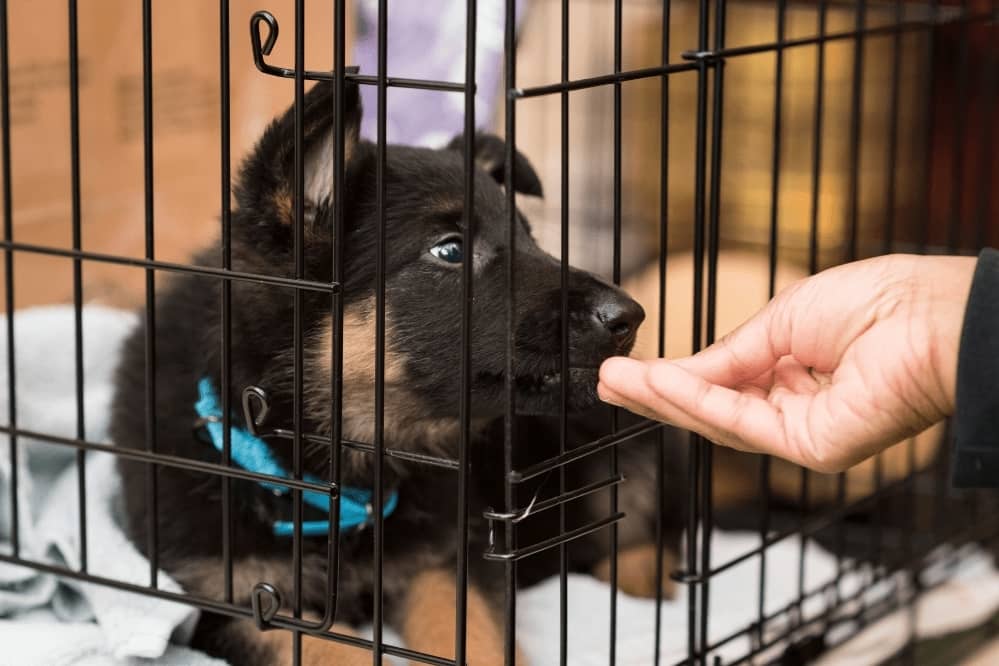Crate training a dog can be very useful for many different purposes. A dog that is crate trained sees its crate as its home, it’s happy place, and it helps provide them with an area that feels like it belongs to them.
Moreover, a crate trained dog is much less likely to roam around your home when you are gone, to shred your belongings, and it can be very useful to have your dog in a crate when guests come over too. There’s also the fact that you may have to transport your dog in a crate.
For all of these reasons, it is highly recommended that you crate train your dog. However, what if your dog also happens to suffer from separation anxiety?
Dealing with a dog that has separation anxiety is hard enough on its own. Trying to crate train a dog can be extremely difficult when they suffer from separation anxiety, but that said, it is possible. Let’s talk about how you can make crate training a dog with separation anxiety much easier.
Tips for Crate Training an Anxious Dog
What is important to note is that here we are going to focus more on the separation anxiety issue rather than the crate training. It’s going to be near impossible to crate train a dog with severe separation anxiety, so this needs to be addressed before anything else.
1. Regular Training & Confidence Building
The first way to help get rid of your dog’s separation anxiety is to build its confidence. The more confident the dog is, the less anxiety is should suffer from when you leave the house. Building confidence in your dog is easily done with regular training sessions.
Set aside a few 5-minute training sessions each day and practice basic commands like sit, down, stay, come, and so on and so forth. Also, you need to be very positive when doing this, using lots of treats as rewards to reinforce that good behavior. Using food treats to reward good behavior can go a very long way in building confidence.
2. Training Your Dog for Independence
Separation anxiety in dogs is characterized by them never wanting to be alone. This can go as far as not even wanting to be alone in a single room of your home. Does your dog follow you around all day when you are at home, never letting you out of its sight? If so, this is a sign of extreme separation anxiety, and this needs to be corrected before you can start getting rid of that anxiety when you leave the home.
Start by going back to those commands you taught your dog, mainly down and stay. You need to get to the point where you can get your dog to lay down and stay in a single room while you move throughout the house. Tell your dog to lay down and then move away from her for a few seconds, but still remain in the same room.
Once the dog stays down for a few seconds as you move away from it, increase this time to 30 seconds, then to 1 minute. Eventually, you can then leave the room while your dog stays in another room.
The key here is to return to the dog before it gets upset or starts showing signs of anxiety. This is going to take a lot of repetition, but you should eventually get to the point where you can spend any amount of time in another room without the dog following you.
3. Creating a Comfort Zone
The next step to crate training a dog with separation anxiety is to create a comfort zone for them, and here you need to start off with the crate. If you plan on crate training a very anxious dog, before you attempt to leave the home, the dog first needs to feel comfortable inside of that crate.
Start off by keeping the lid off of the crate and putting your dog’s food and water inside of it. Also add a soft blanket or its favorite bed, as well as some of its favorite chew toys too.
If your dog is too weary of the crate and refuses to go inside of it, even with all of its favorite stuff in there, try keeping the food dish, beds, and toys close to the crate, and as the days go on, keep moving these things closer to the crate, and then eventually inside of the crate.
In other words, here you want to follow a basic crate training routine, but at this point you are not leaving the house yet. This is all about making the dog feel at home in the crate and nothing more.
4. Combining Steps 2 & 3
Now that your dog feels comfortable inside of the crate and you can manage to walk around the house without the dog following you around, it is time to put the previous two steps together. Get your dog to lay down inside of the crate, give it a toy to chew on, tell it to stay, and try to leave the room.
At this point, if you closely followed the previous steps, you should be able to get the dog to lay down in the crate and stay there as you leave the room.
Only leave the room for a few seconds and always return before the dog gets upset and anxious. As time goes on, you should be able to leave the room for longer periods of time, all with the dog in the crate and without it getting anxious.
5. Leaving the Home
The hardest step here is going to involve leaving your home, as this is when the separation anxiety usually kicks in.
As you are leaving, keep a steady routine. Get your keys, get your purse or wallet, tie your shoes, and so on and so forth. Keep repeating these same steps several times per day without actually leaving. These signs that you are leaving are often triggers for the separation anxiety. So, keep doing your “leaving the house” routine without actually leaving the house. When your dog no longer reacts to your cues or routines, then you can start leaving the house.
One big tip here is to not acknowledge your own departure or arrival. This means that you should not cuddle your dog when you leave or when you return, none of that “mommy will be back soon” stuff.
Get your dog to lay down in the crate, and then just leave without making a big deal of it. The same goes for greetings. Try ignoring the dog for about 15 minutes prior to leaving and for 15 minutes after returning. This will help show the dog that you being gone is not a big deal.
If your dog shows signs of anxiety as you are leaving the home, do not try to comfort or reassure it, as this will only reinforce the anxiety. Just leave. You can also start this process by only leaving for a few seconds or minutes. Get your dog to go into the crate, give it a toy, leave the house, and then come back in a few minutes, preferably before the dog gets anxious.
You can then leave your house for longer periods each time you do this. Only increase the time you are gone by a few seconds or a minute. Many people find that turning the TV or radio on helps a lot, as it may make the dog feel like someone is home.
Conclusion
Crate training a dog with separation anxiety is no easy task, mainly because here you are trying to accomplish two things at once, crate training and separation anxiety training. The most important tip-top follow here is to be kind and patient with your dog. If you start getting anxious and frustrated, your dog will pick up on that energy and it’s only going to get worse.

